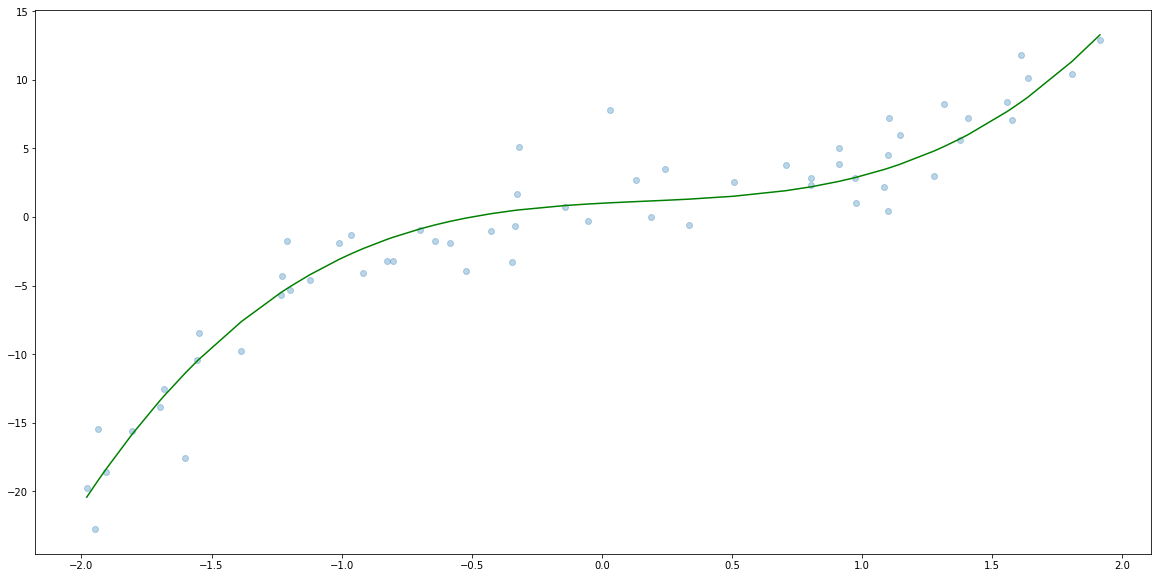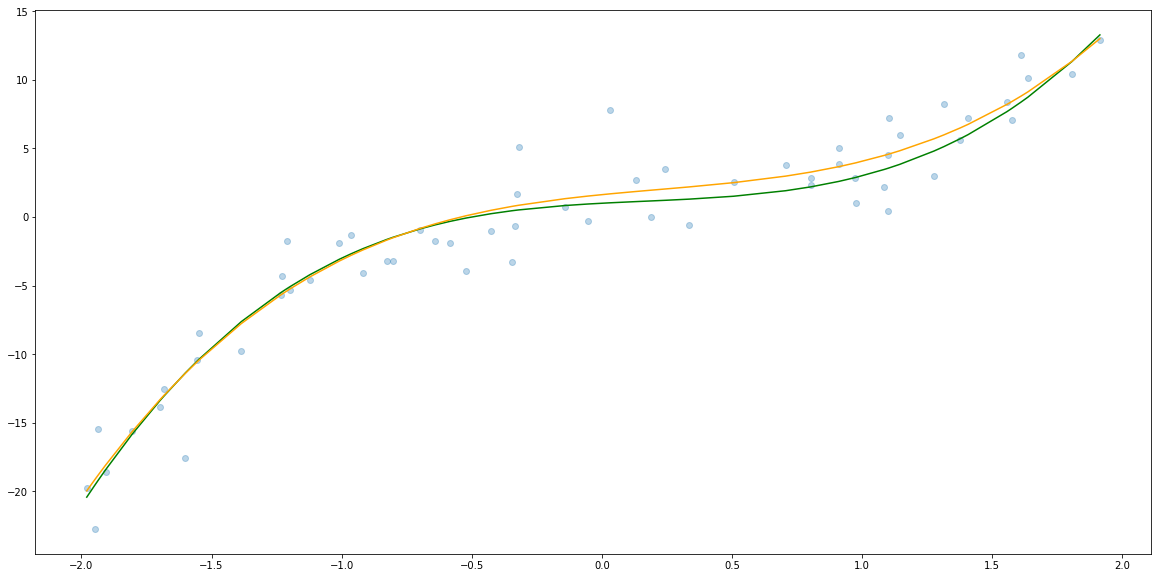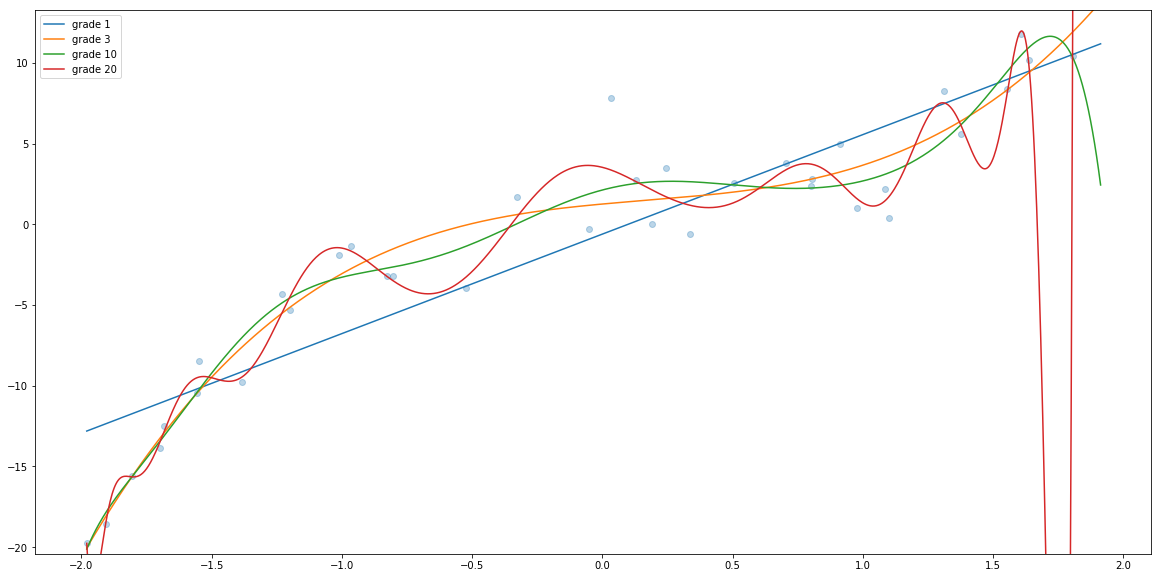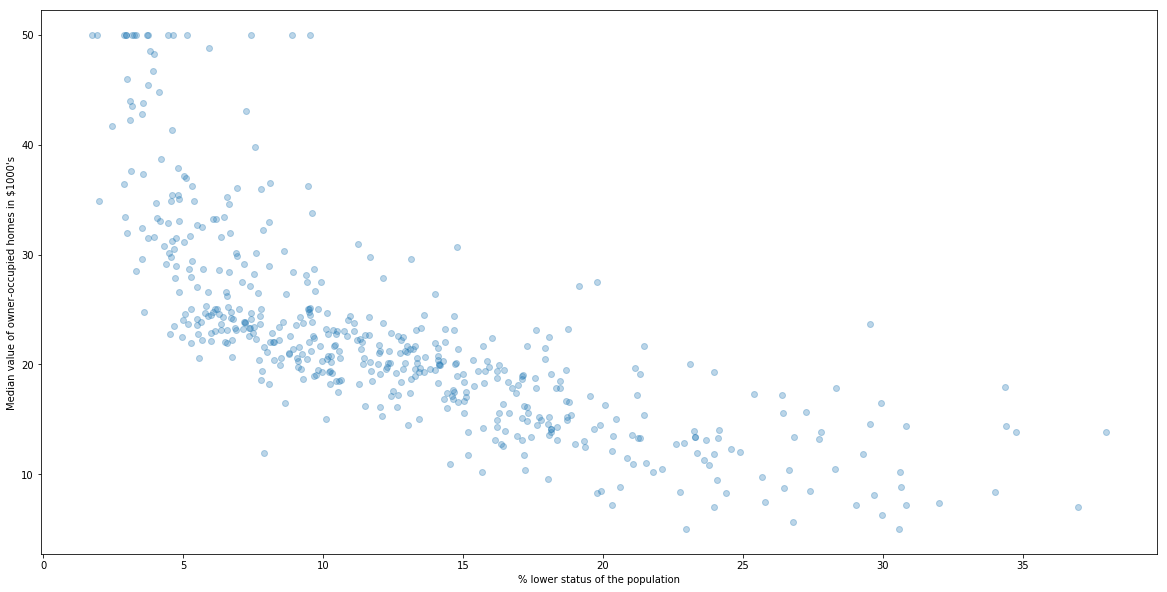Machine Learning Part 4: Bias–Variance Trade-Off in Polinomial Regression
In this note we would like to explain two concepts.
- What is Bias–Variance Tradeoff
- What the Polinomial Regression is.
import matplotlib.pyplot as plt
import matplotlib
import numpy as np
import pandas as pd
from sklearn import datasets
matplotlib.rcParams['figure.figsize'] = [20, 10]
Simulated data
In order to have a better ilustration of the concept we are talking about in this section we are going to simulate 500s $(x_i, y_i)$ that follow the formula
\[y = 2 x^3 - x^2 + x + 1 + \varepsilon_i\]where $\varepsilon_i$ follow normal distribution with $\mu = 0$ and $\sigma=2$.
Let’s see what exactly it means.
First, we choose uniformly 1000s $x_i$ from the interval $(-2, 2)$.
N = 60
np.random.seed(seed=666)
x = np.random.uniform(-2, 2, N)
Next, let’s generate 1000s $\varepsilon_i$ and caluculate $y_i$.
sigma = 2
epsilon = np.random.normal(loc=0, scale=sigma, size=N)
f = lambda x: 2 * x**3 - x**2 + x + 1
y = f(x) + epsilon
Now let’s plot $x_i$, $f(x_i)$ and $y_i$.
plt.scatter(x, y, alpha=0.3)
x_sorted = np.sort(x)
plt.plot(x_sorted, f(x_sorted), c="green")
[<matplotlib.lines.Line2D at 0x7fa51e812668>]

Model
So let’s try to buld a model that predict $y_i$. That is a model
\[y = a_1 x + a_2 x^2 + a_3 x^3 + b.\]Of course we would expect that the trained model would have $a_1$, $a_2$, $a_3$ and $b$ as close to $1$, $-1$, $2$ amd $1$ as close as possible.
So far we have been dealing only with linear models. So how can we build polinomial model? The answer is quite easy.
First, we are going to create a data set that contains 3 columns $x_1=x$, $x_2=x^2$, $x_3=x^3$. Then we are actually trying to find the best model of the form
\[y = a_1 x_1 + a_2 x_2 + a_3 x_3 + b.\]So this problem can be reduce to multilinear regression.
Building and trainig the model
Hence in order to train and test the model we will do the following steps.
- Create a function that prepare data with columns $x$, $x^2$ and $x^3$
- Split data into train and test.
- Build a model.
- Fit the model to train data.
- Evaluate model on test data.
# 1. Create a function that prepare data with columns x, x^2 and x^3
def create_dataset_with_powers(x, max_power=3):
x_column = np.expand_dims(x, 1) # this change vector to columns
return np.concatenate([x_column**i for i in range(1, max_power+1)], axis=1)
# 2. Split data into train and test.
from sklearn.model_selection import train_test_split
x_train, x_test, y_train, y_test = train_test_split(x, y)
X_train = create_dataset_with_powers(x_train)
X_test = create_dataset_with_powers(x_test)
# 3. Build a model.
from sklearn.linear_model import LinearRegression
reg = LinearRegression()
# 4. Fit the model to train data.
reg.fit(X_train, y_train)
# 5. Evaluate model on test data.
from sklearn.metrics import mean_squared_error, r2_score
y_test_hat = reg.predict(X_test)
print("RMSE: ", np.sqrt(mean_squared_error(y_test, y_test_hat)))
print("R2 score: ", r2_score(y_test, y_test_hat))
RMSE: 2.3219467250684667
R2 score: 0.8864020209554593
plt.scatter(x, y, alpha=0.3)
x_sorted = np.sort(x)
plt.plot(x_sorted, f(x_sorted), c="green")
plt.plot(x_sorted, reg.predict(create_dataset_with_powers(x_sorted)), c="orange")
[<matplotlib.lines.Line2D at 0x7fa51bec5630>]

And finally let’s check the coeficients.
reg.coef_, reg.intercept_
(array([ 1.87311658, -1.16075182, 1.71730895]), 1.6260112475477435)
So not far from $1$, $-1$, $2$ amd $1$.
How the performance depends on degree of the polynomial
Of course we know that that our model was a polynomial model with degree 3. But in general we do not know it. So how can we find out what is the degree? This is done by trainig several models with defferent degrees and test which one performs best.
Note Since we use test set as a set for chosing $n$, we should do further splitinig into train, dev and test sets.
Therefore we are going to execute the following steps.
- Create a function that prepare data with columns $n$ columns $x$ $x^2$ … $x^n$ (already done)
- Split data into train, dev and test.
- Create a function that build polynomial model of degree $n$, fit it and report performance on dev.
- Evaluate different models and record performance.
- Choose best model.
- Evaluate model on test data.
# 1. Create a function that prepare data with columns $n$ columns x x^2 ... x^n
# Already done, see function create_dataset_with_powers
# 2. Split data into train, dev and test.
x_train_dev, x_test, y_train_dev, y_test = train_test_split(x, y, random_state=666, test_size=0.2)
x_train, x_dev, y_train, y_dev = train_test_split(x_train_dev, y_train_dev, random_state=667, test_size=0.25)
# 3. Create a function that build polynomial model of degree n, fit it and report performance on dev.
def evalute_polinomial_model(degree, x_train, x_test, y_train, y_test):
X_train = create_dataset_with_powers(x_train, degree)
X_test = create_dataset_with_powers(x_test, degree)
reg = LinearRegression()
reg.fit(X_train, y_train)
y_train_hat = reg.predict(X_train)
y_test_hat = reg.predict(X_test)
mse_train = mean_squared_error(y_train, y_train_hat)
mse_test = mean_squared_error(y_test, y_test_hat)
return np.sqrt(mse_train), np.sqrt(mse_test), reg
# 4. Evaluate different models and record performance.
MAX_DEGREE = 20
performance = pd.DataFrame()
regs = []
for degree in range(1, MAX_DEGREE+1):
mses = evalute_polinomial_model(degree, x_train, x_dev, y_train, y_dev)
new_row = pd.DataFrame({
"degree": [degree],
"RMSE_train": [mses[0]],
"RMSE_dev": [mses[1]]
})
performance = performance.append(new_row, ignore_index = True)
regs.append(mses[2])
# 5. Choose best model.
performance.set_index("degree")
| RMSE_dev | RMSE_train | |
|---|---|---|
| degree | ||
| 1 | 4.153637 | 3.296009 |
| 2 | 3.003129 | 2.889720 |
| 3 | 2.381115 | 1.975418 |
| 4 | 2.413264 | 1.967882 |
| 5 | 2.384761 | 1.962849 |
| 6 | 2.388675 | 1.912717 |
| 7 | 2.421321 | 1.804209 |
| 8 | 2.434080 | 1.802891 |
| 9 | 2.432787 | 1.802520 |
| 10 | 2.401902 | 1.790641 |
| 11 | 2.402251 | 1.790634 |
| 12 | 2.699702 | 1.646397 |
| 13 | 2.703162 | 1.644626 |
| 14 | 2.837589 | 1.490849 |
| 15 | 2.839522 | 1.490133 |
| 16 | 2.845882 | 1.489783 |
| 17 | 2.832935 | 1.488909 |
| 18 | 2.720069 | 1.396046 |
| 19 | 2.719239 | 1.388898 |
| 20 | 2.949630 | 1.358178 |
# 6. Retrain the best model on both train and dev and evaluate on test data.
evalute_polinomial_model(3, x_train_dev, x_test, y_train_dev, y_test)
(2.076447010476317,
2.4703261707591064,
LinearRegression(copy_X=True, fit_intercept=True, n_jobs=None,
normalize=False))
plt.scatter(performance["degree"], performance["RMSE_train"], alpha = 0.3, c="blue")
plt.plot(performance["degree"], performance["RMSE_train"], alpha = 0.3, c="blue")
plt.scatter(performance["degree"], performance["RMSE_dev"], alpha = 0.3, c="orange")
plt.plot(performance["degree"], performance["RMSE_dev"], alpha = 0.3, c="orange")
plt.xticks(performance["degree"])
plt.ylim((1, 4.5))
plt.show()

xs = np.linspace(np.min(x), np.max(x), num=1000)
plt.ylim((np.min(f(xs)), np.max(f(xs))))
plt.scatter(x_train, y_train, alpha=0.3)
for degree in [1, 3, 10, 20]:
Xs = create_dataset_with_powers(xs, degree)
ys = regs[degree-1].predict(Xs)
plt.plot(xs, ys, alpha=1, label="grade " + str(degree))
plt.legend()
<matplotlib.legend.Legend at 0x7fa519a03780>

Exercise: Boston dataset
Now let’s try to analyze Boston dataset.
from sklearn.datasets import load_boston
data = load_boston()
X = data.data[:, [12]]
y = data.target
plt.scatter(X[:, 0], y, alpha=0.3)
plt.xlabel("% lower status of the population")
plt.ylabel("Median value of owner-occupied homes in $1000's")
plt.show()

There is a clear polinomial realtion. Could you find the best polinomial?
Next In the next part we will explain how to evaluate classification models. See Machine Learning Part 5: How we evaluate classification algorithms
Updated: 2019-02-19